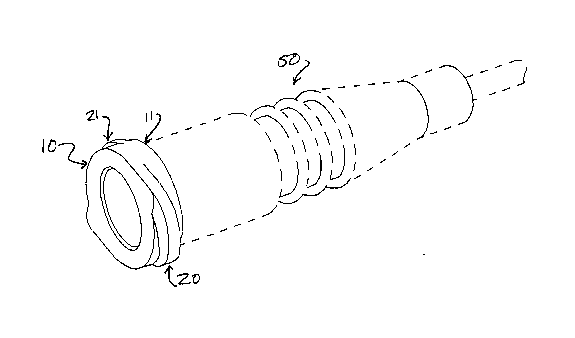Une partie des informations de ce site Web a été fournie par des sources externes. Le gouvernement du Canada n'assume aucune responsabilité concernant la précision, l'actualité ou la fiabilité des informations fournies par les sources externes. Les utilisateurs qui désirent employer cette information devraient consulter directement la source des informations. Le contenu fourni par les sources externes n'est pas assujetti aux exigences sur les langues officielles, la protection des renseignements personnels et l'accessibilité.
L'apparition de différences dans le texte et l'image des Revendications et de l'Abrégé dépend du moment auquel le document est publié. Les textes des Revendications et de l'Abrégé sont affichés :
| (12) Demande de brevet: | (11) CA 2156577 |
|---|---|
| (54) Titre français: | CONNECTEUR FILETE POUR INSTRUMENT MEDICAL |
| (54) Titre anglais: | THREADED CONNECTOR FOR A MEDICAL DEVICE |
| Statut: | Réputée abandonnée et au-delà du délai pour le rétablissement - en attente de la réponse à l’avis de communication rejetée |
| (51) Classification internationale des brevets (CIB): |
|
|---|---|
| (72) Inventeurs : |
|
| (73) Titulaires : |
|
| (71) Demandeurs : |
|
| (74) Agent: | GOWLING WLG (CANADA) LLP |
| (74) Co-agent: | |
| (45) Délivré: | |
| (22) Date de dépôt: | 1995-08-21 |
| (41) Mise à la disponibilité du public: | 1996-03-17 |
| Requête d'examen: | 1995-08-21 |
| Licence disponible: | S.O. |
| Cédé au domaine public: | S.O. |
| (25) Langue des documents déposés: | Anglais |
| Traité de coopération en matière de brevets (PCT): | Non |
|---|
| (30) Données de priorité de la demande: | ||||||
|---|---|---|---|---|---|---|
|
The threaded connector of this invention meets the ISO 594-2 Luer Lock Connectorstandard. This threaded connector is a modified female 6% Luer lock conical fitting with
external threads. The threaded connector of this invention defines a pair of external threads,
the mid points of which are located 180 degrees apart. Each of these threads extends only
about 140 degrees to about 170 degrees around the outer surface of the tubular body
defining the connector. The ends of the threads taper smoothly into the outer surface of the
connector.
Note : Les revendications sont présentées dans la langue officielle dans laquelle elles ont été soumises.
Note : Les descriptions sont présentées dans la langue officielle dans laquelle elles ont été soumises.

2024-08-01 : Dans le cadre de la transition vers les Brevets de nouvelle génération (BNG), la base de données sur les brevets canadiens (BDBC) contient désormais un Historique d'événement plus détaillé, qui reproduit le Journal des événements de notre nouvelle solution interne.
Veuillez noter que les événements débutant par « Inactive : » se réfèrent à des événements qui ne sont plus utilisés dans notre nouvelle solution interne.
Pour une meilleure compréhension de l'état de la demande ou brevet qui figure sur cette page, la rubrique Mise en garde , et les descriptions de Brevet , Historique d'événement , Taxes périodiques et Historique des paiements devraient être consultées.
| Description | Date |
|---|---|
| Inactive : Morte - Taxe finale impayée | 1999-11-08 |
| Demande non rétablie avant l'échéance | 1999-11-08 |
| Réputée abandonnée - omission de répondre à un avis sur les taxes pour le maintien en état | 1999-08-23 |
| Inactive : Lettre officielle | 1998-11-26 |
| Inactive : Correspondance - Poursuite | 1998-11-16 |
| Réputée abandonnée - les conditions pour l'octroi - jugée non conforme | 1998-11-06 |
| Inactive : Taxe finale reçue | 1998-10-07 |
| Lettre envoyée | 1998-05-06 |
| Un avis d'acceptation est envoyé | 1998-05-06 |
| Un avis d'acceptation est envoyé | 1998-05-06 |
| Inactive : Renseign. sur l'état - Complets dès date d'ent. journ. | 1998-05-01 |
| Inactive : Dem. traitée sur TS dès date d'ent. journal | 1998-05-01 |
| Inactive : Approuvée aux fins d'acceptation (AFA) | 1998-03-17 |
| Demande publiée (accessible au public) | 1996-03-17 |
| Toutes les exigences pour l'examen - jugée conforme | 1995-08-21 |
| Exigences pour une requête d'examen - jugée conforme | 1995-08-21 |
| Date d'abandonnement | Raison | Date de rétablissement |
|---|---|---|
| 1999-08-23 | ||
| 1998-11-06 |
Le dernier paiement a été reçu le 1998-07-16
Avis : Si le paiement en totalité n'a pas été reçu au plus tard à la date indiquée, une taxe supplémentaire peut être imposée, soit une des taxes suivantes :
Les taxes sur les brevets sont ajustées au 1er janvier de chaque année. Les montants ci-dessus sont les montants actuels s'ils sont reçus au plus tard le 31 décembre de l'année en cours.
Veuillez vous référer à la page web des
taxes sur les brevets
de l'OPIC pour voir tous les montants actuels des taxes.
| Type de taxes | Anniversaire | Échéance | Date payée |
|---|---|---|---|
| TM (demande, 2e anniv.) - générale | 02 | 1997-08-21 | 1997-07-23 |
| TM (demande, 3e anniv.) - générale | 03 | 1998-08-21 | 1998-07-16 |
Les titulaires actuels et antérieures au dossier sont affichés en ordre alphabétique.
| Titulaires actuels au dossier |
|---|
| BECTON, DICKINSON AND COMPANY |
| Titulaires antérieures au dossier |
|---|
| FLOYD V. EDWARDS |
| GERALD H. PETERSON |
| M. PARKE BYRON |